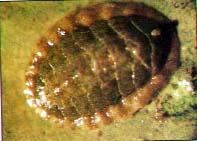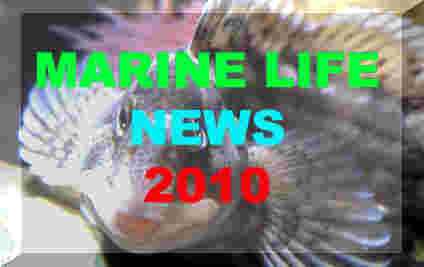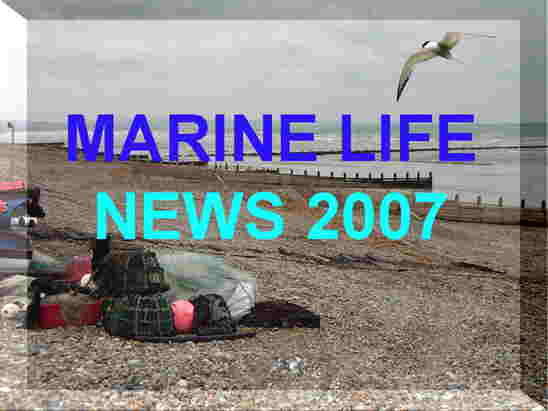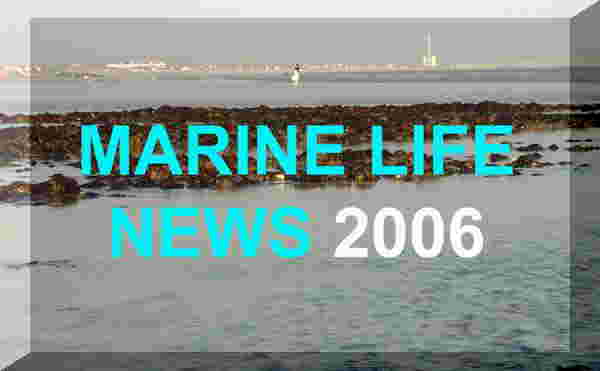
 |
Mollusca
Mollusca
Latin molluscus = softSoft bodied animals with a hard external shell (mussels, winkles, snails), or an internal shell (sea hares, cuttlefish) or have lost their shell in the course of evolution (nudibranchs). Molluscs have a mantle that secretes the calcium carbonate that makes up the shell. They inhabit numerous different environments with a large number living in the sea.
Octopuses and squids have evolved to intelligent mobile forms with complex behaviour.

Class Polyplacophora
Chitons
The commonest and most widespread chiton found on British rocky shores is Lepidochitona cinerea. On many shores it is the only species to be found.
Class Scaphopoda
Tusk ShellsClass Gastropoda
| Hardy's Internet Guide to Marine Gastropods |
| Checklist of European Marine Mollusca |
| Mollusca of the NE Atlantic & NW Europe on facebook |
It is in this class of animals
that the typical spiral snail-like molluscs are classified. However, unlike
land
snails, the marine ones breathe through gills to obtain oxygen from
sea water. Gastropods have a feeding organ called
a radula.
Subclass Prosobranchia
(Marine Snails) front-gilled snails.
Most of this taxa contain
a spirally-coiled shell and a prominent foot on which it crawls around.
The foot can usually be retracted in the shell. The opening is called the
aperture. They breathe through gills.
Winkles
(External) http://museum.nhm.uga.edu/GSC/newsletr/FEB194.html
Mediterranean
Topshells, Trochidae http://www.turin.net/shell/trochus.html
Pages under construction: Dogwhelks, Limpets, Whelks, Winkles, Topshells
12
January 2001
Jim Hall discovered
the curious lamellarid mollusc called Lamellaria perspicua
on a bare boulder on the extreme lower shore (on a spring tide) of Lydstep
beach, 3 miles from Tenby, SW Wales.
Order: Vetigastropoda
Family: Halotidae (Abalones)
1
May 1998:
Green
Ormer Database file
Daniel
L. Geigers Homepage (Malacology)
http://www.lam.mus.ca.us/~dgeiger/Index.html
12
March 2005
Stan
Breban, a scallop fisherman brought me a Knobbed
Triton, Charonia lampas, which
he caught in his scallop dredge somewhere in the Little Russel to the east
of Guernsey in the Channel Islands.
The whole animal weighed 541 grams (drained) and had a total shell length of 16.5 cm. It had a shell width of 10.5 cm and a shell height of 7.5 cm. This large gastropod mollusc is expected to find a home in Guernsey Public Aquarium at St. Peter Port.
on the Marine Wildlife of the North-east Atlantic Ocean Group
16 October 1999
John Shuker from Sark caught a Knobbed Triton, Charonia lampas (L.), to the west of Sark, north of Les Hautes Boues and south of Brehou Island. (About 2 ° 23 minutes 30 West and 49 ° 25 minutes 30 North). It measures 222 mm total length. Weight drained 1128 grams. The specimen is alive. I took the triton to the Guernsey Aquarium on Monday. Since receiving the specimen I have spoken with some fishermen. Maurice Downs, now a sand eel fisherman, says that in the late 1960's during the queen scallop fishery boom he and several other dredge fishermen caught a couple each. I was told that a scallop diver, Richard Keen, picked up a few in the late 1980's or early 1990s. The Guernsey aquarium kept one for about eight years in one of their tanks. They recently had two from local waters but they died within days of each other. This specimen was caught in gill nets set for fish.
Another one from Cornwall
Aphotomarine
31
January 1998:
Jon
Makeham discovered the unusual gastropod mollusc Lameillaria
latens under a rock at low water on Hannafore Beach, Looe. These gastropods
were covered by a mantle that felt leathery. Two specimens were discovered,
one was brown, the other a carmine red. The species was identified by the
internal shell.
Subclass Opisthobranchia
(Sea Slugs)
Gastropods that have lost
their protective hard shell during the evolution of the species.
Akera
bullata
Video
footage by Penny Martin
(Orkneys)
This
interesting study shows the Sea
Hare (=Akeroidea),
an opisthobranch
gastropodmollusc,
swimming
rather awkwardly with their heavy (shelled) end hanging down, rather like
a large heavy beetle flying.
Nudibranchs
(BMLSS Records)
Tylodina
perversa
This sea slug featured as
a discovery news item.
Grey
Sea Slug, Aeolidia papillosa (photograph)

Sea Hare, Aplysia fasciata
Aplysia, the size if which (between 30 & 35 cm) indicates that it is Aplysia fasciata. It was photographed swimming in Helford River, Cornwall. It was seen on 25 August 2007 by Steve Potter.
Aplysia fasciata is the largest and the rarest of the three species of sea hare found in the British Isles. It is an Atlantic species, found from the Channel to Angola (South west Africa and to Brazil) and also throughout the Mediterranean. It appears to reach its northern limit in Ireland and along the Channel coast of England.
It is one of the largest sea slugs in the world. The other two British species are the relatively common Aplysia punctata variable in colour and growing to 20 cm; and the uncommon Aplysia depilans with different shaped back lobes, brown or green and growing to a maximum of 30 cm.
Sea
Hare,
Aplysia depilans, News Report
Sea
Hare, Aplysia punctata
(photograph of juvenile)
Sea
Hares,
Aplysia punctata. Autumn report from Cornwall
Sea
Hares,
Aplysia punctata. May report from Cornwall
Bernard
Picton's Nudibranch Site
http://www.pictonb.freeserve.co.uk/nudibranchs/index.html
Sacoglossan
Sea Slug Elysia
viridis
Photograph by Andy Horton
 This
small sea slug occurs on the shore in the south and west of the British
Isles. On juveniles the green or blue spots may be absent. It is reported
to feed on the seaweed Codium, but it has been discovered where
this weed is absent.
This
small sea slug occurs on the shore in the south and west of the British
Isles. On juveniles the green or blue spots may be absent. It is reported
to feed on the seaweed Codium, but it has been discovered where
this weed is absent.
It has been recorded from the Old Fort (opposite Kingston Beach on the other side of the Adur estuary), Shoreham-by-Sea, Sussex, where the only weed immediately noticeable is Fucus serratus. If you search you will probably find Ulva and Enteromorpha, and I have discovered Cladophora growing on the Fucus.
I have also discovered this sea slug in whelk egg cases. Andy Horton
Subclass Pulmonata
(Terrestrial and freshwater Snails) lunged snails.
Class Bivalvia (=Pelecypoda)
Lamellibranchia or Bivalvia (Mussels, Cockles, Venerids, Piddocks, Scallops, Oysters etc.)Amande Glycymeris glycymeris
Bivalve
Molluscs of Norway (Thumbnails by UW Photo)
Molluscs
on the Lulworth Bank, Dorset Coast, English Channel
Oyster
& the Slipper Limpet
Piddocks
Razorfish
(News Item)
Teredo
(Shipworm)
December 2012
Gaping
File Shell
Photograph
by Darryl Mayer (Dive
Tramp)
Darry
Mayer Photograph Gallery
Fife
Powerboat
Training Centre
A massive colony of the Gaping File Shell, Limaria hians, has been discovered in Loch Alsh, a sea inlet between the Isle of Skye and the western Scottish mainland. The reef habitat covers an astonishing 4.6 sq miles (7.5 sq km) and was discovered during a survey commissioned by Marine Scotland. It is the largest known colony of Gaping File Shells in seas around the British Isles and possibly the world. Numbers of the bivalve mollusc exceed 100 million and they create their own specialised habitat with unique fauna.
12
May 2009
A
large native European Oyster,
Ostrea
edulis, weighing 1.36 kg, width
180 mm, length 170 mm and depth 70 mm was spotted on Plymouth fish
market in a box of mixed fish bought by merchant,
Peter
Randall of Mevagissey, and is now in the Mevagissey
Aquarium.
on the Marine Wildlife of the NE Atlantic Ocean (Yahoo Group)
28
October 2007
A
Quahog
Clam, Arctica islandica,
dredged up off the coast of Iceland was thought to be between 405 and 410
years old and the oldest animal alive on Earth until it was killed. Researchers
from Bangor University in north
Wales said they calculated its age by counting rings on its shell.
6 January
2005
A
walk along the Sandwich Bay seafront revealed the first 2005 record of
the pretty bivalve mollusc Moerella
donacina, (pic)
a type of tellin which was only discovered to be present at Sandwich in
2004.
Sandwich
Bay (non-avian) Nature 2005
17
January 2004
The
pretty bivalve mollusc Moerella donacina
(pic)
was
collected by the Kent Shoresearch group at Sandwich Bay. This is the first
known record of the mollusc from this area. The record was submitted by
F.
Booth.
Kent
& Medway Biological Records Centre Monthly Records 2004
Class Cephalopoda
Octopuses, Cuttlefishes, Squids etc.
Cuttlefish Sepia officinalis
BMLSS Octopus
Identification guide for shelf cephalopods in the UK waters (North Sea, the English Channel, Celtic and Irish Seas)
Message: 10
Date: Mon, 16 Oct 2000 11:12:32 +0100
From: "Stella Turk" <stella@reskadinnick.fsnet.co.uk>
Subject: Spirula on the strandline
Yesterday Richard Driver (with Paul Gainey) found, amongst other items, the coiled shell of Spirula spirula. This tiny cephalopod (more closely related to the cuttlefish than the octopus) is believed to live in the depths of the Sargasso sea. Shells are occasionally cast up on the western coasts of Britain and various countries of mainland Europe, but never - so far - with the remains of the living animal. This one was found on Perranporth Beach, Cornwall, and was exceptionally large at 25 mm (one inch), as they are rarely more than half an inch. I must do some surfing to find out what the latest research has to offer about this small mollusc.
Stella
Turk
Report
on Vince
Smith's One-List/Cornish Wildlife
Architeuthis:
the Giant Squid
BMLSS
Octopus
Cephalopod
Page (NHM Host)
Cephalopod
pages at the National Museum of Natural History, Washington DC
Colours
of Shells, Why?
Conchological
Society
Conchological
Society EForum
Cuttlefish
Page
Cuttlefish
Pages (Matt Stribley)
Cuttlefish
Report 2000 (Cornwall)
Common
Octopus News Report
Curled
Octopus
EuroSquid
Seashells
of Eigg
Sepiola
(Little Cuttle)
Shellfish
Poisoning (Harmful Algae Page)
Shell
Pigments (Ref.)
Squids
& Squid Eggs masses
NEWS
21
July 1999
A
new licensing scheme is being proposed by the Government to protect crustaceans
and other shellfish from being over-exploited. Fisheries Minister Elliot
Morley said that there has been "increasing concern about the rate of exploitation
of shellfish stocks in UK waters. The current state of shellfish stocks
requires us to make progress in conserving this vulnerable resource. The
new scheme is likely to reduce the number of boats fishing for shellfish
to around 3,000...."
The
value of the shellfish industry in the UK is now £165 million, or
one third of all UK fish landings.
http://www.bbc.co.uk/animalzone/93news3.shtml

EMail Glaucus@hotmail.com
 Conchological Society of Great Britain
and Ireland
Conchological Society of Great Britain
and Ireland
|
|
|
|
|
News 2018 |
Membership Form |
|







